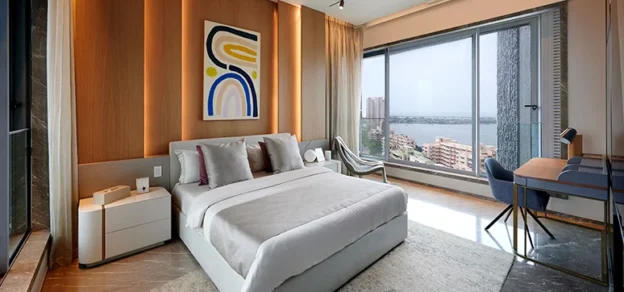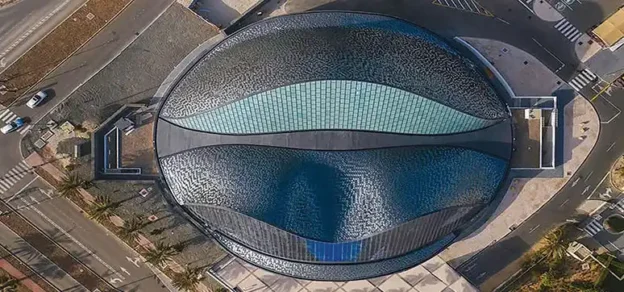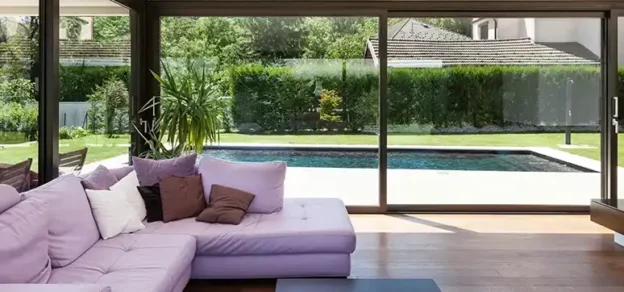IMPORTANCE OF ACOUSTICS IN FAÇADE DESIGN
A façade of a building defines its visual identity, allows light in, provides a fire barrier to protect occupants and addresses thermal requirements. It also shapes and responds to the external noise environment around the building and controls the intrusion of environmental noise (“noise pollution”) into spaces within.
Noise pollution is now known as a global public health concern. In 1995, the World Health Organization (WHO) declared, “… these effects [of noise] have a detrimental influence on well-being and perceived quality of life”. Among other issues, noise pollution has been scientifically linked with sleep disturbance, hearing functionality, increased blood pressure and heart disease. In Europe, this has been translated into a societal cost estimated to be 40 billion Euros annually. Closer to home, in 2019, Dubai residents filed more than 2,500 noise complaints to the municipality.
The world is also getting noisier. The UN predicts that, by 2050, two-thirds of people will live in cities. India is projected to have another 416 million urban dwellers than it does now, with China adding 255 million and Nigeria 189 million. And as cities swell, there are signs we are finding it harder to cope with the noise. For example, the UK government’s most recent National Noise Attitude Survey found “… a strongly statistically significant increase” in the proportion of respondents who reported being disturbed by road traffic, neighbours, aircraft and construction. The COVID-19 pandemic has also shown us that human population mobility directly and significantly affects environmental noise levels.
Legislation and guidance differ between countries, however, most align with each other in terms of controlling noise intrusion to suitable levels to avoid adverse health effects. The following is a guide on factors to consider in façade design to effectively control environmental noise intrusion into buildings.
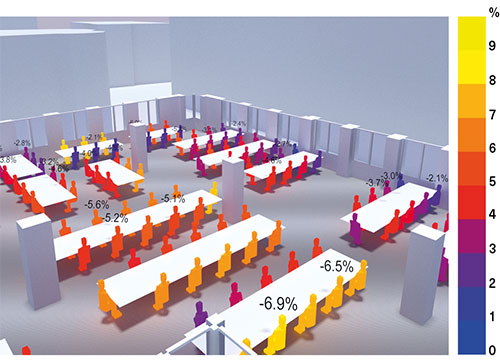
EARLY WINS
Implementing measures to reduce noise pollution in a completed building can prove costly, with requirements for secondary glazing systems built within the constraints of the existing façade system, or even entirely separate from it, taking up valuable floor space, effectively reducing the market value of the building (affecting gross internal area and aesthetics).
The most effective way to deal with environmental noise is at the start of a project, by appointing a suitably qualified acoustic consultant who will undertake an assessment of the proposed building location and massing by either measuring or predicting noise levels [Figure 1] (or a combination of both) that will be incident on the building’s façade. The results of this assessment can then be used to inform the architect’s early design in terms of site location, building orientation, positioning of noise-sensitive rooms within the development, optimising internal layouts (such as using productivity mapping [Figure 2]), designing in building elements that offer acoustic screening and efficient glazing configurations. Fundamentally, an early noise study can even help dictate site suitability.
GLAZING SPECIFICATION
Typically, the part of a façade system offering the least noise reduction is the glazing. However, where potential noise issues are present, the building façade should be assessed holistically by a suitably qualified acoustics consultant. Considerations include the glass configuration; acoustic losses from framing details, mullions and transoms; ventilation openings and other acoustically weak façade constructions such as certain types of cladding systems.
There are several other factors to consider which are often overlooked, such as:
• Glazing performance is not just STC or Rw
Sound Transmission Class (STC) is a laboratory-measured value originally developed to evaluate speech attenuation and is commonly used in the US. The Weighted Sound Reduction Index, or Rw, is also a laboratory-measured value, commonly used in the rest of the world and also limited to certain frequencies. Consequently, neither of the above may completely consider exterior noise sources that are generated at lower frequencies (i.e. below 100 to 125 Hz). A fuller frequency evaluation is therefore required to determine appropriate façade constructions.
The OITC measurement was developed in 1990 and was intended to evaluate attenuation due to typical exterior noises such as buses, construction, and sirens. The OITC rating emphasizes low-frequency noise in the evaluation more than the STC rating since the ambient environment has more of these sound sources compared to speech.
Rw + Ctr is Rw with the addition of a low-frequency sound correction factor Ctr (always a negative number). Rw + Ctr is used because of the increase in low-frequency sound sources such as traffic or aircraft noise.
• Double glazing is not always better at reducing noise than single glazing
Often thermal performance requirements govern the use of double glazing over single, however, consider the following table in relation to the sound insulation of different constructions.
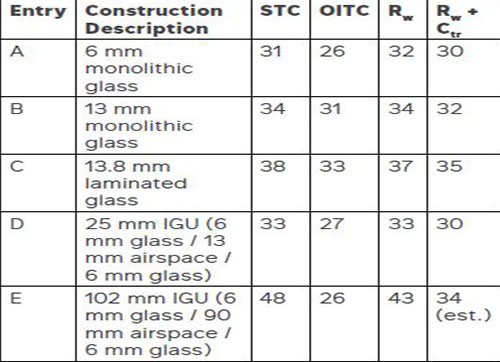
constructions
Typical glazing systems have small airspaces resulting in resonances in the range of 150 to 190 Hz, which is more noticeable to people, relevant to speech privacy, and included in the evaluation in Table 1. As an example, 13 mm monolithic glass has a rating of STC 34 (entry B in Table 1), while a 25-mm Insulated Glass Unit (IGU) consisting of 6 mm glass, 13 mm airspace, and 6 mm glass (entry D in Figure 1) will result in STC 33 for the same area of glass. It is also important to note the effect of larger airspace between glazing panes by comparing entries D and E in Figure 1.
Each glass thickness has a weakness in a particular frequency (resonant, or natural, frequency) which results in a ‘coincidence dip’ in performance. Using two (or three) panes of glass in a casement that have the same thickness can compound this weakness, leaving a noticeable loss in performance at certain frequencies. One project our engineers worked on was to investigate noise problems in a building fitted with triple glazing next to a busy railway track. The window casement was found to be three panes of 6 mm glass, separated by 4 mm each; the coincidence dip of 6 mm glazing is around 2 kHz, which coincides with the squeal of brakes of the trains, resulting in bedrooms where most external noises were cut out, except for the brake squeal which appeared amplified, resulting in residents not being able to sleep.
Laminated glass can improve acoustical separation by allowing for an impedance change in the material (the mass-spring-mass principle). When sounds or vibrations experience changes in density, part of the noise is reflected back in the direction it originated. Thus, by including a thin layer of polyvinyl butyral (PVB) or ethylene-vinyl acetate between two thin layers of glass, the change in density between the glass and the lamination layer causes the reflection of some of the sound energy. A piece of 13 mm plate glass (entry B in Figure 1) provides acoustical separation of STC 34, while a piece of 13.8 mm laminated glass (entry C in Figure 1) offers acoustical separation of STC 38.
It should also be noted that glazing performance (for the same glazing configuration) changes depending on pane/panel size, getting worse as the pane gets larger.
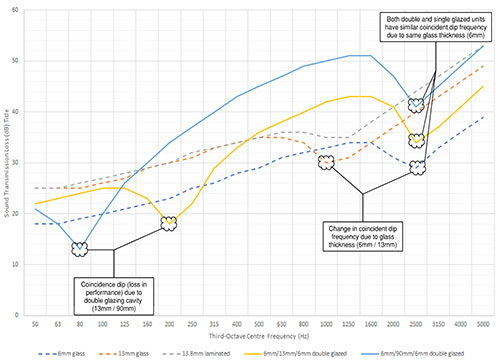
• External noise levels can increase with building height?
There is a common misconception that buildings are quieter on upper levels. Generally, in urban areas, the higher up, distance attenuation is cancelled out by increased angle of view, exposure to other noise sources (including rooftop plants on podium levels and other lower building roofs) and the Canyon Effect (where sound bounces off adjacent buildings). Cundall has been involved in several projects where measurement data has backed this up.
• Connection of the façade to the building’s interior
Curtain walls and floor-to-floor detailing are important. It is not just noise coming in that has to be considered with the façade, but connections of the façade to the building structure, usually via mullions and transoms, is an acoustical weak point. A robust partition or floor specification can be severely compromised if there is a weak point in the façade connection. In tall buildings it is necessary also to allow for movement of the façade to account for wind loading and other environmental factors – careful design is required to ensure that this movement does not compromise the sound insulation performance of walls and floors (similar to deflection at partition heads).
EFFECTS OF FAÇADE SHAPE
Various studies have been undertaken on the shape of façades and façade elements on noise pollution, both inside the buildings and on the street. A 2019 study on the effect of façade shape and acoustic cladding on the reduction of leisure noise levels in a street canyon summarises the following regarding balcony shapes:
• Balconies slightly shield the façade from noise in the street.
• Increased balcony depth reduces sound pressure level (SPL) on the pertaining façade up to 1 dB.
• Sound-absorbing balconies and loggias reduce the SPL over the façade up to 6.5 dB.
• An entirely sound-absorbing façade reduces SPL on the façade itself up to 9.5 dB.
• A sound-absorbing street paving achieves 1 dB in noise reduction over the façade.
A study in 2015 also concluded the following:
“Different building shapes can lead to variations of up to 9 dBA as for road traffic sound pressure levels for pedestrians. Building-façade design can reduce the average value along a window with 8.5 dBA. The geometric configuration of the street can increase the positive effect of low barriers and reduce 11 dBA in pedestrian exposure.”
THERMALLY-INDUCED NOISE ISSUES
All components of the building allow the façade to properly expand and contract. Without providing slip connections and avoiding rigid connections between the façade and interior components such as the acoustical ceiling grid, pops and creaks occur as the two components heat up differently and attempt to expand.
WIND-INDUCED AERODYNAMIC NOISE
Aeroacoustic noise is unwanted sound generated when turbulent air passes over an object, stimulating audible frequencies. Recently, aeroacoustic noise has become a subject of concern for buildings, where façade elements such as screens and shading devices may create wind-induced noise. Façade elements of concern are typically perforated screens that provide shade and privacy while allowing natural ventilation and preserving views of the outdoors. However, other elements such as tightly spaced louvers, brise soleil, and even vanity tower elements can also be problematic (just Google “Beetham Tower noise”).
CONCLUSIONS
So, the façade design is not simple. Every design decision has an impact on multiple factors that need careful consideration by relevant experts.




